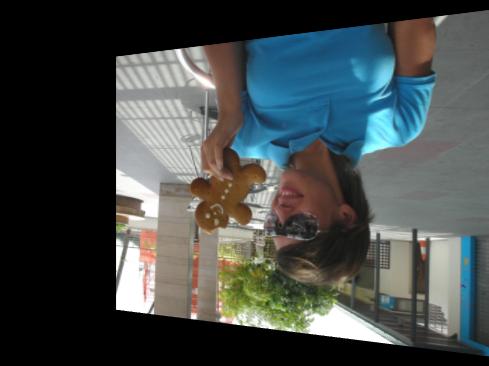9.20 LookAt
There are two distinct ways of making things move in our 3D world. One way is to move the actual pictures around the screen using the Translate effect. The other way is to move our virtual camera around (yup, we got a camera yo!). A good way to conceptualize this is to treat all of what we see on the screen as being recorded on a camera. So this effect actually allows us to move our camera/eye around in our 3D world.
| Parameters |
| Default |
| Range |
| Description |
| eyex |
| 0.0 |
| n/a |
| x coordinate of the position of the camera/eye. |
|
|
|
| ||||
| eyey |
| 0.0 |
| n/a |
| y coordinate of the position of the camera/eye. |
|
|
|
| ||||
| eyez |
| 0.0 |
| n/a |
| z coordinate of the position of the camera/eye. |
|
|
|
| ||||
| centerx |
| 0.0 |
| n/a |
| x coordinate of the point the camera camera/eye is looking at. |
|
|
|
| ||||
| centery |
| -1.0 |
| n/a |
| y coordinate of the point the camera camera/eye is looking at. |
|
|
|
| ||||
| centerz |
| 0.0 |
| n/a |
| y coordinate of the point the camera camera/eye is looking at. |
|
|
|
| ||||
| upx |
| 0.0 |
| n/a |
| x component of the normalized vector that defines the "up" orientation. |
|
|
|
| ||||
| upx |
| 0.0 |
| n/a |
| y component of the normalized vector that defines the "up" orientation. |
|
|
|
| ||||
| upx |
| 0.0 |
| n/a |
| z component of the normalized vector that defines the "up" orientation. |
9.20.1 Examples
9.20.1.1 Camera motion example.
; muSE v2 ; ; My good-looking style. ; This style changes the position and orientation of the viewing camera. (style-parameters) (segment-durations 8.0) (define muvee-global-effect (effect-stack (effect "CropMedia" (A)) (effect "Perspective" (A)))) (define muvee-segment-effect (effect "LookAt" (A) (param "eyez" 0.0 (linear 1.0 1.0)) (param "upy" 1.0 (at 0.5 -1.0)) (param "centerx" 0.0 (linear 1.0 1.0))))
This is an example that’s doing some funky stuff with our camera. The eyez parameter is animated to move from 0.0 to 1.0 for the whole duration. What that really means is we are moving our camera along the positive z-axis. But since our picture is placed by default at z = -2.14, the net impression will be that our picture in moving away from us. The second parameter inverts the upy at progress = 0.5 (which is basically in the middle of a segment). So the net effect to us will be a sudden image inversion in the middle of each segment. Finally centerx goes from 0.0 to 1.0 during the duration of the segment. The net effect will be that our picture will appear to be rotating along the y-axis. Do note that in real terms, our picture is not moving at all, we are only moving the camera. Refer to Explicit animation curves for more info on how we animate the parameters.
